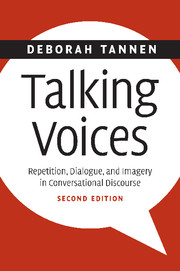Book contents
- Frontmatter
- Contents
- Acknowledgments
- 1 Introduction to first edition
- Introduction to second edition
- 2 Involvement in discourse
- 3 Repetition in conversation: toward a poetics of talk
- 4 “Oh talking voice that is so sweet”: constructing dialogue in conversation
- 5 Imagining worlds: imagery and detail in conversation and other genres
- 6 Involvement strategies in consort: literary nonfiction and political oratory
- 7 Afterword: toward a humanistic linguistics
- Appendix I: Sources of examples
- Appendix II: Transcription conventions
- Notes
- List of references
- Author index
- Subject index
3 - Repetition in conversation: toward a poetics of talk
Published online by Cambridge University Press: 23 December 2009
- Frontmatter
- Contents
- Acknowledgments
- 1 Introduction to first edition
- Introduction to second edition
- 2 Involvement in discourse
- 3 Repetition in conversation: toward a poetics of talk
- 4 “Oh talking voice that is so sweet”: constructing dialogue in conversation
- 5 Imagining worlds: imagery and detail in conversation and other genres
- 6 Involvement strategies in consort: literary nonfiction and political oratory
- 7 Afterword: toward a humanistic linguistics
- Appendix I: Sources of examples
- Appendix II: Transcription conventions
- Notes
- List of references
- Author index
- Subject index
Summary
Repeating then is in every one, in every one their being and their feeling and their way of realizing everything and every one comes out of them in repeating.
Gertrude Stein, The gradual making of “The Making of Americans” Lectures in America, p. 214Apparently there has been no other subject during my entire scholarly life that has captured me as persistently as have the questions of parallelism.
Roman Jakobson, Dialogues by Roman Jakobson and Krystyna Pomorska, p. 100Theoretical implications of repetition
According to Hymes (1981), the patterning of repetitions and contrasts is no less than a definition of structure itself. Hymes discusses the inadequacy of an early translation of a Chippewa (Ojibway) poem which changes what he calls its “structure”: “its points of constancy and variation,repetition and contrast,” as well as its literal content (41). Hymes explains:
The term “structure” is used here because of my belief that the true structure of the original poem is essential to knowledge of it, both ethnological and aesthetic. By structure, I mean here particularly the form of repetition and variation, of constants and contrasts, in verbal organization. Such structure is manifest in linguistic form. It does not exhaust the structuring of poems… But such structure is the matrix of the meaning and effect of the poem. (42, italics in original)
- Type
- Chapter
- Information
- Talking VoicesRepetition, Dialogue, and Imagery in Conversational Discourse, pp. 48 - 101Publisher: Cambridge University PressPrint publication year: 2007
- 1
- Cited by

